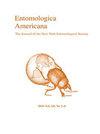明尼苏达州北部褐蝽种群黑色形态的下降(半翅目:蚜科)
IF 0.5
4区 农林科学
Q4 ENTOMOLOGY
引用次数: 1
摘要
由遗传决定的spumarius (Philaenus spumarius, L.)的黑色形态吸收更多的入射辐射,达到更高的平衡温度,并且在较冷的高纬度种群中更频繁。从1974年到2021年,明尼苏达州东北部的五个地区9月平均气温上升了2.70°C,而黑色背色形式的频率显著下降,雌性从22.1%降至14.2%,雄性从12.7%降至7.3%。在男性和女性中,深色腹侧胸膜的频率都有所下降,而在男性中,TYP(两种局部非黑色颜色形式中色素较多的一种)的频率相对于另一种POP表型减少。在伊利诺伊州Tinley Park, 1971 - 2021年气温上升1.85°C,唯一常见的深色形式MAR的频率没有变化,但TYP与POP的相对频率在男性和女性中都有所下降。这些结果表明:1)由于气候变暖,对热黑化的选择有所放松,从而维持了北方黑化的颜色形态;2) MAR频率由其他形式的选择确定,可能选择警告颜色;3)气候变暖可能使TYP和POP之间的表型平衡向POP方向转移。如果这些变化代表了更广泛的地理区域,那么spumarius多态性可能被证明是气候变化的有用晴雨表。本文章由计算机程序翻译,如有差异,请以英文原文为准。
DECLINE OF MELANIC COLOR FORMS IN NORTHERN MINNESOTA POPULATIONS OF PHILAENUS SPUMARIUS (L.) (HEMIPTERA: APHROPHORIDAE)
Abstract Genetically determined melanic color forms of the spittlebug Philaenus spumarius (L.) absorb more incident radiation, reach higher equilibrium temperatures, and are more frequent in cooler, higher latitude populations. Across five Northeastern Minnesota localities from 1974 to 2021 mean September temperature increased 2.70°C, while melanic dorsal color forms decreased significantly in frequency, from 22.1% to 14.2 % in females, and 12.7% to 7.3% in males. The frequency of dark ventral abdominal pleurites decreased in both males and females, and in males the frequency of TYP, the more pigmented of the two local non-melanic color forms, decreased relative to the alternative POP phenotype. In Tinley Park, Illinois, where temperature increased 1.85°C from 1971 to 2021, the frequency of MAR, the only common dark color form, did not change, but the relative frequency of TYP versus POP decreased in both males and females. These results suggest that: 1) northern melanic color forms are maintained by selection for thermal melanism, selection that has relaxed as a result of warming climate; 2) MAR frequencies are determined by other forms of selection, possibly selection for warning coloration; and 3) climate warming may shift the phenotypic balance between TYP and POP toward POP. If these changes are representative of broader geographical areas, the P. spumarius polymorphism may prove to be a useful barometer of climate change.
求助全文
通过发布文献求助,成功后即可免费获取论文全文。
去求助
来源期刊

Entomologica Americana
ENTOMOLOGY-
CiteScore
0.30
自引率
0.00%
发文量
0
审稿时长
>12 weeks
期刊介绍:
Entomologica Americana, the journal of The New York Entomological Society, publishes original research on the taxonomy, classification, phylogeny, biogeography, behavior and natural history of insects and other arthropod taxa. Manuscripts are published as research articles, shorter scientific notes or book reviews.
 求助内容:
求助内容: 应助结果提醒方式:
应助结果提醒方式:


